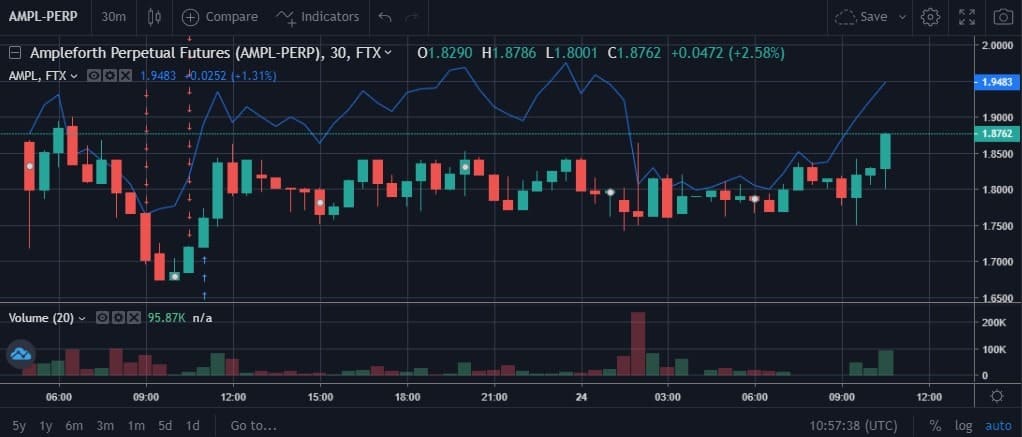Ampleforth (AMPL) was listed on the popular cryptocurrency derivatives and spot exchange FTX yesterday.
While a spot listing is something that no one would question, FTX also listed AMPL for futures trading under their Perpetual contract. This raised more than a few eyebrows, mainly because of the cryptocurrency’s underlying mechanics and its impact on spot prices.
Less than a day after the listing, the price for AMPL shot up to $13,000, which, according to the CEO of the exchange, was “an error in the spot AMPL books for a few users.”
What Happened with AMPL’s Listing on FTX?
On July 23rd, FTX listed Ampleforth’s token AMPL for trading on its spot and derivatives platform. To many, this was a cause for celebration. FTX is one of the more popular exchanges by volume and users, and a listing on it should, in theory, be a driver for further adoption of the cryptocurrency.
FTX adopted a similar approach as other exchanges when it comes to spot trading of AMPL. Because of the protocol’s mechanism to adjust the supply in accordance with the current market and target price, FTX would disable withdrawals for AMPL, pause trading, conduct the daily rebalancing of portfolio, unpause trading, and enable withdrawals once again.
This isn’t much different than what KuCoin and Bitfinex (the other major exchanges supporting AMPL at the time of this writing) are doing.
However, the listing didn’t go without its fair share of issues. Users on Twitter reported that the price for AMPL had suddenly shot up to $13,000 on FTX, which is an astonishing increase from its rate of around $1.8 at the time of the incident.
Broke: when $BTC 13k
Woke: when $AMPL 13k 😎 pic.twitter.com/5C3jPGc8xt— Awawat (@Little_Awawat) July 24, 2020
The CEO of the exchange took it to social media to explain what happened.
“Around 3 PM, there was an error in the spot AMPL books for a few users. We found and resolved that error.
No other markets were affected. All trades within standard price bands will remain. No accounts were adversely affected. Really sorry about the crazy print!” – He said.
Trading for both spot and perpetual contracts was disabled for the duration of the problem and resumed shortly after.
AMPL on Perpetual Contracts and Why This is Odd
As mentioned above, FTX also decided to list AMPL tokens for trading through a perpetual futures contract that tracks the price of the underlying asset. In other words, users are now able to gain both long and short exposure to AMPL’s price.
And while this might seem completely reasonable for other cryptocurrencies, AMPL is different. As CryptoPotato explained, Ampleforth’s protocol has embedded features that make its price somewhat predictable to a certain extend.
Because the protocol is written to keep the price relatively stable at around $1, when the current market rate is lower or higher than this target, the protocol inflates or deflates the current supply of tokens on the market.
The main thing to know is that this happens every single day at a given hour – 02:00 UTC. In other words, traders can easily predict whether or not the price for AMPL will increase or decrease based on its current market price. Not only that but because the formula is easily calculated, they can even know the approximate span of the price movement.
Now, this is where it becomes interesting. Unlike the spot exchange, trading of AMPL perpetual contracts on FTX will not be paused during the rebase period.
As some Twitter users pointed out, this creates a situation where, when the price of AMPL is higher than its target price, someone could easily go short on FTX’s perpetual contract, while also holding a spot position to receive the rebase. This way, they will make money while the expected price correction takes place and still receive the rebase.
Of course, if something sounds too good to be true, it usually isn’t. This wasn’t the case with the first rebase that took place on FTX.

We dissected the price action on 1-minute intervals and compared the perpetual contract trading to that of spot pairs on AMPL on FTX, KuCoin, and Bitfinex.
The price dipped at the exact same moment after the exchanges resumed trading following the distribution of tokens, meaning that short positions on AMPL on the FTX perpetual contract would have profited.
In any case, it remains interesting to see how these perpetual contracts will pan out in the future and whether FTX will encounter other issues with the AMPL token being listed on its platform.
Click here to start trading on BitMEX and receive 10% discount on fees for 6 months.
The post appeared first on CryptoPotato






